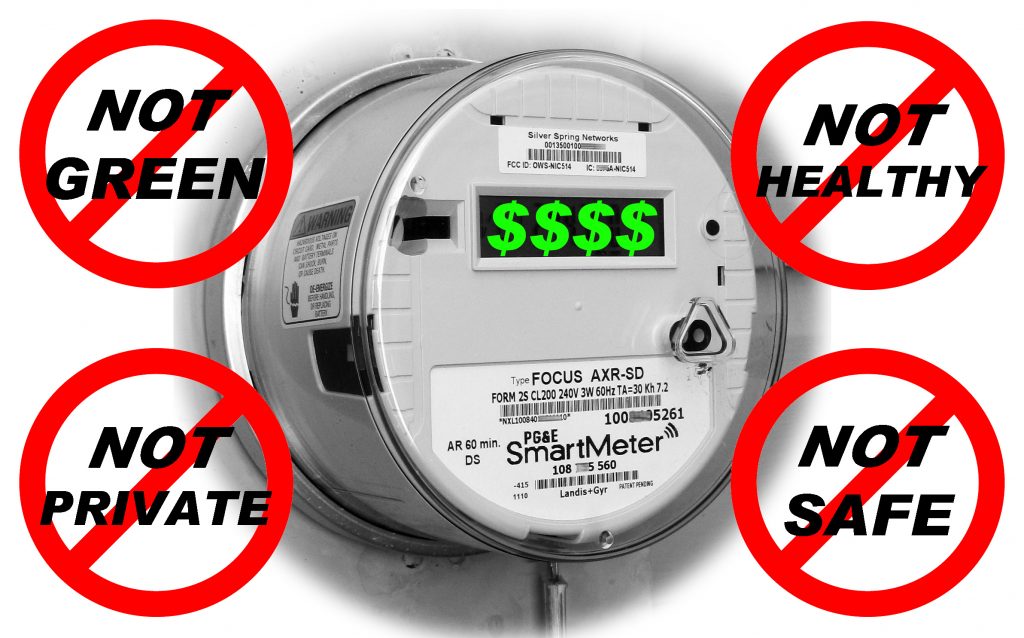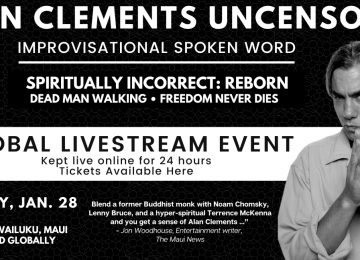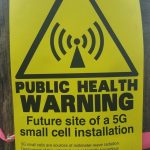Maui’s electric utility has taken an extraordinary step in proposing to only provide new smart meters to customers who request them. The decision is likely the first time that a utility anywhere in the nation has adopted such a radical proposal. Across the United States, people have either been forced to accept a smart meter replacement for their analog meter, or pay an “opt-out” fee, in places like California, of more than $400, to not take the forced “upgrade.”
Pitched as a boon to consumers, their deployment seems like one of the biggest cons ever imposed on the American public. They don’t save consumers money, they emit harmful radiation, they are susceptible to hacking, they have caused homes to burn down, and they contribute to unemployment as meter readers are being fired across the nation.
At a Grid Modernization community meeting on Maui in August, Colton Ching, a Hawaiian Electric vice president, announced the proposed plan would allow customers the choice of getting a smart meter. Maui Electric Co. had previously announced that they would offer an “opt out” provision for those who didn’t want them.
Maui environmental health educator Debra Greene hailed the decision as a major victory for consumers who had protested smart meter deployment. “It’s huge,” she says. “I want to believe we had an impact. Smart meters represent a real hazard and this significant development is the first incident we know of where a state’s major utility has changed policy to opt in. It’s unprecedented in the United States.”
“The only real purpose of smart meters is to create additional revenue streams for utilities because they collect extraordinary amounts of data about what people are doing inside their homes that the utility can turn around and sell.”
Greene explains: “In Early 2017, several dozen Notices of Liability (and Non-Consent) were sent by customers to the Hawaiian Electric utility heads who were planning on blanket-installing smart meters. Now, Hawaiian Electric has announced their complete shift to an ‘opt in’ plan, in which the utility must receive explicit consent from the homeowner in order to install a smart meter.”
Greene, the founder of KeepYourPower.org, a Maui-based educational service that provides consumer information about smart meters and smart-grid technologies, says the new decision, “affects all the islands except for Kauai, which has its own utility, and is already blanketed with over 30,000 smart meters.”
Last year Hawaiian Electric filed a grid modernization plan with state regulators which involved installing more than 455,000 smart meters on Oahu, Hawai’i Island and in Maui County at a cost of $340 million. Smart meter installation was supposed to begin in 2018 on Hawai’i Island and in Maui County.
Colton Ching said the new meters would be employed for sensing and monitoring purposes for customers with photovoltaic (PV) rooftop solar systems. This would help keep the grid stable when electricity demand may exceed the amount of generation capacity that may fluctuate with variable solar and wind power sources. Ching added that if a customer’s analog meters broke, they would be offered a new digital meter with the radio frequency transmitter turned off.
Greene says it looks like new utility customers and PV system owners connecting to the grid will have to have mandatory smart meters installed. “So they are making people opt in, because they know liability is going to be an issue. Colton Ching said they are also counting on analog meters becoming obsolete so that soon they won’t be able to buy anything except for a smart meter, but I don’t know that’s true. The more we learn about smart meters the less desirable they become. ”
Governments across the world have become obsessed with smart meters (also called AMI or AMR meters). The global smart meter market is anticipated to reach $49.9 billion by 2025, according to a report by Grand View Research, Inc.
Consumers Digest in a 2011 review declared, “smart-meter conversion represents little more than a boondoggle that is being foisted on consumers by the politically influential companies that make the hardware and software that are required for the smart-meter conversion.”
Smart meters emit electromagnetic radio waves similar to cell phones or Wi-Fi routers to communicate with centralized computers that keep real-time tabs on customers’ power use. Some consumers and health practitioners claim these repeated pulses cause serious symptoms such as headaches, insomnia, imbalance, tinnitus and heart problems. A number of web sites feature reports by many people whose health has suffered.
The American Academy of Environmental Medicine has called for a halt to smart meter deployment.
“Chronic exposure to wireless radiofrequency radiation is a preventable environmental hazard that is sufficiently well documented to warrant immediate preventative public health action,” the AAEM announced in a statement. “Multiple studies correlate RF exposure with diseases such as cancer, neurological disease, reproductive disorders, immune dysfunction, and electromagnetic hypersensitivity. Many in vitro, in vivo and epidemiological studies demonstrate that significant harmful biological effects occur from non-thermal RF exposure.”
Utilities claim their meters are safe as they only transmit a few times per day and at very low frequencies. However a study by Sage Associates showed that in California, Pacific Gas & Electric’s smart meter RF emissions are significantly more powerful than previously thought. The study predicted significantly higher radiofrequency radiation levels and more FCC public safety limit violations in some smart meters.
“The emissions from one meter are strong enough that the public is put at risk from exposures outward from the meter from approximately one foot to over six feet, depending on the reflection factor,” said Cindy Sage, Sage Associates. “For multiple meters at the same location, the zone of impact where FCC limits may be violated is somewhere between three feet and 19 feet, depending on the reflection factor.”
“People have no idea how high their chronic RF exposure might be,” noted Barry A. Smith of the Environmental Health Coalition of West Marin. “In reality, each smart meter functions like a cell antenna, relaying signals from other meters, and adds significantly to the existing radiation exposure already in the environment.”
Michigan-based electrical engineer William Bathgate reported in public testimony: “I have personally tested the RF emissions from the AMI meter and measured that the meter does not send data just a few times a day as the utilities publish. It actually sends an RF pulse about every 4-5 seconds constantly and a longer duration RF emission after midnight running about 3-5 minutes. The meters themselves are “dangerous or hazardous” due to their lightning vulnerabilities, EMI and RF emissions. There has been a disregard for the health and safety effects of these AMI meters on the general population by the utilities.
“It’s one thing to be on a cell phone for one hour per day, but if you are exposed to smart meter or a cell tower, you are exposed 24/7 so the effect is cumulative,” noted Professor Dr. Henry Lai, University of Washington’s Bioelectromagnetics Research Laboratory.
While utilities have promoted them as a way for consumers to save money by closely monitoring their usage – as if we don’t know a light bulb uses less electricity than a fridge – independent studies have found the claims are marginal at best.
In Ontario, Canada, where smart meters were introduced at a cost of about $1 billion, researchers compared data after time-of-use rates were introduced in 2011 with more than 20,000 household customers. Residential demand for electricity just dropped 2.6 percent during on-peak periods and 2.4 percent during mid-peak periods following the change.
Illinois Attorney General Lisa Madigan reported, “Consumers don’t need to be forced to pay billions for so-called smart technology to know how to reduce their utility bills. We know to turn down the heat or air conditioning and shut off the lights. The utilities have shown no evidence of billions of dollars in benefits to consumers from these new meters, but they have shown they know how to profit. The only real question is: How dumb do they think we are?”
Community resistance to smart meter deployment in California led to the Sebastopol City Council voting to ban the wireless meters in 2013. Fairfax City Council also passed a ban on meter installation. The California Public Utility Commission called the city bans illegal and a violation of federal law.
Other smart meter issues include inflated bills. A Dutch study found some meters can give false readings up to 582% higher than actual energy consumption. There’s a worrying issue of fire hazards. They are extremely vulnerable to hacking. “Imagine you woke up to find you’d been robbed by a burglar who didn’t have to break in,” noted Netanel Rubin of the Vaultra security firm. And they are a major invasion of privacy.
In conclusion Debra Greene says, “as much as I see this as a victory and cause for celebration, I’m a little skeptical. I’m concerned it’s a strategy. The original proposal to blanket rollout smart meters was rejected by the PUC, so now they will go piecemeal. The PUC suggested an ‘opt in’ policy. Hawaii is unique in that people from all over the world come to these islands to heal and escape, and if the islands are blanketed with smart meters there’s a significant number of people who would be affected, especially those who are electro-sensitive.”
More information about smart meters in Hawaii is available at – http://stopsmartmetershawaii.com/
More information about the health issues associated with smart meters is available at – http://healthimpactnews.com/2017/smart-meters-countdown-to-a-national-crisis-of-illness-and-death/






































